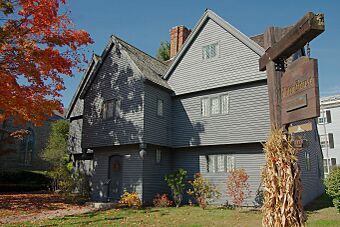The Witch House facts for kids
Quick facts for kids |
|
|
Jonathan Corwin House
|
|
|
U.S. Historic district
Contributing property |
|
 |
|
| Location | 310 Essex Street Salem, Massachusetts |
|---|---|
| Built | 1642 (Traditional) c. 1675 (MACRIS) |
| Restored | 1945 |
| Part of | Chestnut Street District (ID73000312) |
The Jonathan Corwin House, often called The Witch House, is a historic house in Salem, Massachusetts. It was the home of Judge Jonathan Corwin from 1675 until he passed away in 1718. This house is one of the few buildings left in Salem that is directly connected to the famous Salem witch trials of 1692. Judge Corwin bought the house when he was 35 years old, and it stayed in his family for many years. Today, the City of Salem manages it as a museum. You can take self-guided tours to learn more about the Salem Witch Trials.
Contents
The Witch House: A Look Back in Time
Early Days and Judge Corwin's Home
The land where the Witch House stands was first owned by Captain Nathaniel Davenport. He started building the house, but it was not finished when Jonathan Corwin bought it in 1675. Corwin quickly completed the house. Back then, it had steep gables, a large chimney in the middle, and a two-story porch sticking out at the front.
Judge Corwin's Role in the Salem Witch Trials
In 1692, during the Salem witch trials, Judge Corwin was asked to help investigate claims of witchcraft. Many accusations of witchcraft were happening in Salem Village (now Danvers) and nearby towns. Corwin took the place of Judge Nathaniel Saltonstall, who had left the court. Judge Corwin served on the Court of Oyer and Terminer. This court made decisions about the accused people. Many people who were accused during this time were brought to Corwin's home for "pretrial examinations." This means they were questioned there before their trials.
Changes to the House Over the Years
After the trials, the house eventually went to Corwin's grandson, George. He owned it until he passed away in 1746. George's wife, Sarah Corwin, made some changes to the house between 1746 and 1747. Rooms were added to the back, and the original gables on the front were removed. A different type of roof, called a gambrel roof, was built over the house.
The Corwin family no longer owned the house after 1836. Later, in 1856, a pharmacist named George Farrington bought it. He built an extra part onto the house towards Essex Street for his medical business. Farrington was the first person to call his home the "Witch House." This name attracted tourists who heard him say that the Witch Trials had happened in his parlor. More additions were made to the back of the house in 1874 and by 1897.
Saving and Restoring the Historic Building
Around the early 1900s, the house was divided into apartments and businesses. These included a drug store and an antiques shop. This continued until about 1940. At that time, the building was in danger of being torn down to make North Street wider. To save the house, it was moved back from the street to where it stands today.
In 1945, architects Frank Chouteau Brown and Gordon Robb restored the building. They tried to make it look like it did in the 1600s. They used old documents and studied the building to figure out how it might have looked. Even though it looks old, much of the house today includes materials from the 1900s. The Witch House is now a museum run by the City of Salem and is open during certain times of the year.
How Old is the Witch House?
Historians have different ideas about when the Witch House was built. It's hard to know the exact date because there haven't been special studies, like dendrochronology (which uses tree rings to date wood), to confirm it. The main question is what happened to the house before Jonathan Corwin bought it partly finished in 1675.
Corwin's family members were the first to suggest a build date, claiming it was built in 1642. However, they didn't have proof. Some older scholars even thought it was built much earlier, in the 1620s or 1630s. They even suggested that Roger Williams, who founded Providence Plantations, might have lived there. However, we know for sure that Jonathan Corwin bought or finished the house around 1675. This date is now generally used as the approximate time the house was completed.
Gallery
-
Sketch of the "Witch House" around 1840 by Nathaniel Hawthorne
See also
- Ropes Mansion - another historic house nearby on Essex Street.
- List of historic houses in Massachusetts
- List of the oldest buildings in Massachusetts
- List of the oldest buildings in the United States












